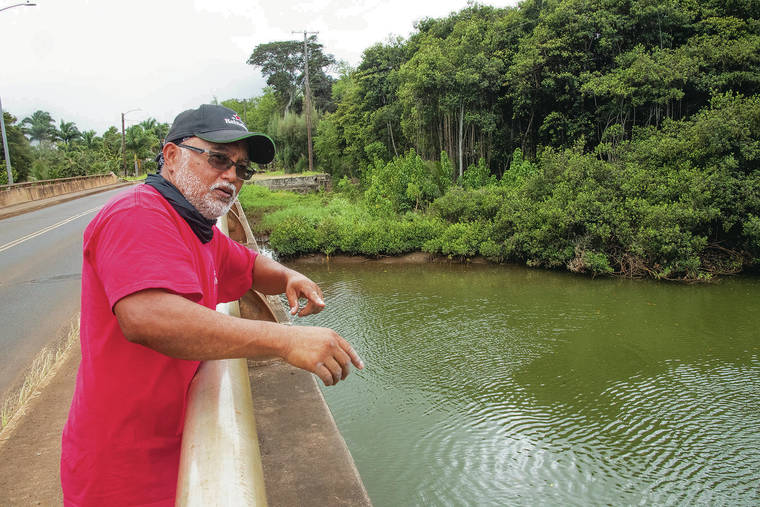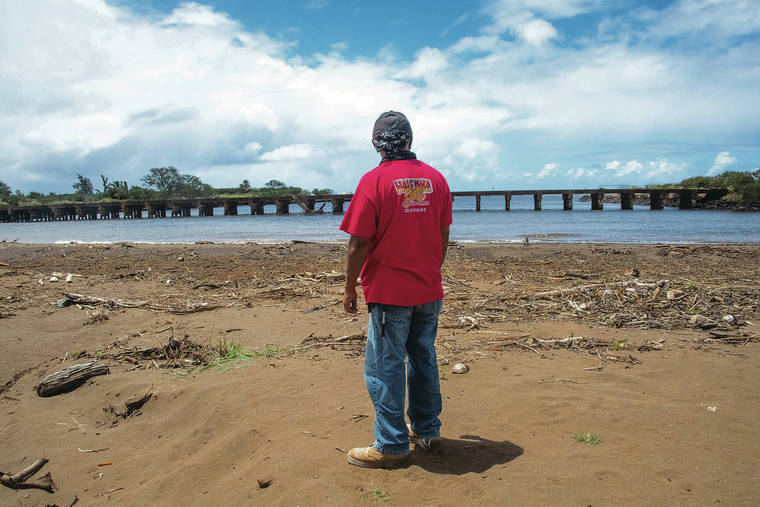Two months after massive flooding from a severe storm caused extensive damage to his property in Haleiwa, resident Derek Gamiao worries when the next storm could hit.
When flashes of lightning and thunder rolled in Thursday night during a flash flood watch issued by the National Weather Service for all of Hawaii, Gamiao, 59, said, “Everybody’s on edge already.”
Flood victims in Haleiwa say dredging at Paukauila and Kiikii streams is necessary to remove sediment buildup and improve water flow, but their pleas to government for assistance have gone unheard for some 25 years. Overgrown mangrove trees that narrow the channel at Paukauila and constrict water flow also need to be cleared.
Damage to Gamiao’s property off of Haleiwa Road Bridge, also known as Long Bridge, is estimated at $80,000 to $100,000. His 2.3-acre parcel is situated next to Paukauila Stream.
Water damage to the exterior walls of a four-bedroom home on his property is visible with stains after the structure was submerged in 2 to 3 feet of floodwaters in the March 9 deluge. Everything inside, from the flooring to appliances, was also destroyed.
A friend created a GoFundMe account at 808ne.ws/derekgamiao Opens in a new tab in the wake of the storm to help the Gamiao family recover. The account has already raised nearly $25,000. Gamiao said he is grateful for the outpouring of support.
“The drywall alone, that by itself is expensive,” he said as he described the damage, which includes an icebox, vanity cabinet and toilets. “Everything, it adds up.”
Flash flooding and torrential rain that severely affected Oahu, primarily the North Shore, between March 8 and 18 damaged more than 60 homes throughout the island. Of those properties, three homes in Haleiwa and one home in Laie were destroyed, according to the city’s initial damage assessment.
This is the second time flash flooding and torrential rain inundated Gamiao’s property in 12 to 15 years. “We’re just waiting for a disaster to happen,” he said in an interview with the Honolulu Star-Advertiser.
According to a 1999 environmental assessment report, “Kiikii and Paukauila Streams are the main watercourses of the largest watershed on the island of Oahu, and are susceptible to high current velocities and large amounts of discharge during storms or flash floods. The watershed extends from the Koolau mountain range above Wahiawa to the outlets of the streams at Kaiaka Bay.”
Four streams converge into two streams: Poamoho and Kaukonahua streams merge to form Kiikii Stream, and Opaeula and Helemano streams combine to form Paukauila Stream. Kiikii and Paukauila streams join and empty into Kaiaka Bay.
Gamiao fears the worse could happen as he recalled three people killed in his neighborhood in a flash flood during a storm in 1974. At the time, he and his family lived on a different property near Haleiwa Road. He remembered that his father, James Gamiao, and other family members tried to rescue a family when floodwaters swept away their Quonset home.
The structure hit Haleiwa Road Bridge and continued down Paukauila Stream before it smashed into Cane Haul Bridge. Other residents also tried to help the family, to no avail.
The bodies of Olympia Bachiller, 36, and her 5-month-old daughter, Leimomi, were found in waters off Haleiwa. Bachiller’s 10-year-old son and Gamiao’s classmate Eugene Bachiller was missing and presumed dead, according to a 1974 Honolulu Star-Bulletin story.
Officials say maintenance at streams is a complex issue, with city and state jurisdictions and different private landowners.
At Paukauila Stream the city has jurisdiction only to maintain 30 feet upstream and 30 feet downstream of Haleiwa Road Bridge. Department of Facility Maintenance crews last cleared the area in June 2019. Crews did not observe any blockage in the area, and the water flowed well during an inspection two weeks ago.
The area is among more than 90 stream locations on Oahu the city maintains under a five-year permit issued by the U.S. Army Corps of Engineers which expires in 2024. Stream maintenance is an important part of flood control, and the city maintains areas under the permit, said Roger Babcock, director of the Department of Facility Maintenance. The permit needs to renewed every five years.
Babcock empathized with flood victims. “It’s tragic when there’s flooding and it’s very, very disruptive,” he said.
Babcock said properties on the bottom of Haleiwa Road are in a flat, low-lying area and are going to get the most flooding because water is accumulating from all the way up the stream, then it hits the bay and it has to dissipate.
Though officials say those properties are susceptible to flooding during heavy rainfall, some Haleiwa residents maintain dredging would reduce flood risks.
There is a section of Kiikii Stream under the city jurisdiction that needs to be dredged, Babcock said. Crews have not been there in a while because the city needs to obtain a permit for the area. The Department of Design and Construction is exploring dredging the section, possibly in 2026.
Portions of Paukauila Stream are privately owned, and the mouth of the stream is under state jurisdiction.
A spokesman for the state Department of Land and Natural Resources said the Paukauila Stream area “is considered an estuary and is not normally disturbed or dredged.”
AJ McWhorter of DLNR’s Communications Office said, “The topography is a low lying/flat area and dredging will unlikely facilitate the discharge of stormwater flows as tidal actions/waters would just fill the area back in.”
A commercial building owned by the Lyons family on Kamehameha Highway near the mauka entrance of Haleiwa town are among the properties damaged in the recent flood. Tackling repairs little by little, Michael Lyons said, “We can’t afford to do it all at once.”
Lyons, who has lived in Haleiwa for more than 50 years, said there is a lot of sediment buildup in the streams. “There’s nowhere for the water to go except for the adjoining properties. So people start flooding.”
State Sen. Gil Riviere (D, Heeia-Laie-Waialua) said dredging the stream is a complicated, costly endeavor. He has communicated with Congressman Kai Kahele to seek federal support to assist flood victims.
In an emailed statement, Kahele said they are working closely with all levels of government to get help to families and communities pummeled by the torrential rain.
The U.S. Small Business Association recently announced low-interest loans that are now available to flood victims, but Lyons questioned how many people will apply, especially with the ongoing impacts of the COVID-19 pandemic. “Do we really want to go out and borrow more money after we had such a terrible year? We can’t afford it. That’s the bottom line. They want to loan it to us for 3%. That’s 3% too much,” he said.
To address flooding, the Honolulu City Council unanimously voted Wednesday to adopt a resolution that requests the administration to develop a comprehensive maintenance schedule of all city-owned streams, including channels, stream beds, stream banks and drainageways and the city’s storm sewer system.
Kathleen Pahinui, chairwoman of the North Shore Neighborhood Board, said it sends a clear message. In a written testimony in support of the resolution, Pahinui said, “The recent flood in Haleiwa was exacerbated due to the lack of stream maintenance as well as not dredging the stream mouth at Kaiaka Bay. Regular stream maintenance is so very critical, especially as we experience sea level rise and rain bombs.”
But a large number of vacancies at the facility maintenance department might present challenges.
Councilwoman Heidi Tsuneyoshi, who represents District 2, which stretches from Mililani Mauka to Kahaluu, cointroduced the resolution with Councilman Tommy Waters.
Major flooding during the March 9 storm also resulted in structural damage to Waialua Beach Road Bridge 605, which runs over Kiikii Stream. The bridge is closed for the next six to nine months until repairs are completed.
Lyons, who also serves as a member of the North Shore Neighborhood Board, stressed that the community is in dire need of assistance to reduce flood risks. Everybody is aware of the issue, but nothing is being done, he said. “People need help. We need assurances that the government is not going to allow this to keep happening.”






